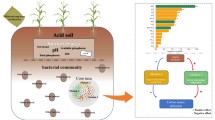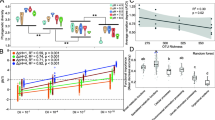Abstract
Characterization of microbial communities is important for understanding the soil biodiversity distribution affected by environmental factors. Here, we combined high-throughput sequencing of 16S rDNA and ITS to investigate the composition of bacterial and fungal communities in interval seawater covering Linchang Island, China. We compared the microbial communities in the soil of three sample points from the southern part to the northern part. No difference was observed in microbial abundance, richness and diversity in those three different locations. In addition, weighted and unweighted UniFrac distances revealed that three soil samples could not be separated from each other, even if the LCNS sample had significantly lower organic matter (OM), sodium and sulfate contents than the LCSS and LCMS samples. This result indicated that the microbial community of the soil may be influenced more strongly by interval seawater than by soil chemical characteristics. The bacterial phyla Proteobacteria, Actinobacteria, Acidobacteria, and Bacteroidetes were the four most abundant phyla in all samples, accounting for 83.22% of the microbial community. Escherichia-Shigella and Vibrio were abundant in the samples and accounted for 1.17% and 0.27%, respectively. Fungal structure, phylogenetic diversity, richness, and bacterial structure had a significant negative relationship with Vibrio abundance. In addition, Vibrio showed negative correlations with the genera Simiduia, Microbulbifer and Haliangium. The results reveal that the re-shaped microbiome and introduced typical microbes could be strategies for inhibiting Vibrio in the soil of Linchang Island.





Similar content being viewed by others
References
Baker-Austin C, Trinanes JA, Taylor NGH, Hartnell R, Siitonen A, Martinez-Urtaza J (2013) Emerging Vibrio risk at high latitudes in response to ocean warming. Nat Clim Change 3:73–77
Burks DJ, Norris S, Kauffman KM, Joy A, Arevalo P, Azad RK, Wildschutte H (2017) Environmental vibrios represent a source of antagonistic compounds that inhibit pathogenic Vibrio cholerae and Vibrio parahaemolyticus strains. Microbiologyopen 6(5):e504
Caporaso JG, Kuczynski J, Stombaugh J, Bittinger K, Bushman FD, Costello EK, Fierer N, Peña AG, Goodrich JK, Gordon JI, Huttley GA, Kelley ST, Knights D, Koenig JE, Ley RE, Lozupone CA, McDonald D, Muegge BD, Pirrung M, Reeder J, Sevinsky JR, Turnbaugh PJ, Walters WA, Widmann J, Yatsunenko T, Zaneveld J, Knight R (2010) QIIME allows analysis of high-throughput community sequencing data. Nat Methods 7:335–336
Carraro N, Rivard N, Ceccarelli D, Colwell RR, Burrus V (2016) IncA/C conjugative plasmids mobilize a new family of multidrug resistance islands in clinical Vibrio cholerae non-O1/non-O139 isolates from Haiti. MBio 7:e00509-e516
Carraturo A, Raieta K, Ottaviani D, Russo GL (2006) Inhibition of Vibrio parahaemolyticus by a bacteriocin-like inhibitory substance (BLIS) produced by Vibrio mediterranei 1. J Appl Microbiol 101:234–241
Chen YG, Zhang ZH, Luo HW, Li Z, Zhang LJ, Huang H (2020) Distinct characteristics of bacterial community in the soil of Nanshazhou Island, South China Sea. Curr Microbiol 77:1292–1300
Clarke KR (1993) Non-parametric multivariate analyses of changes in community structure. Aust Ecol 18:117–143
Corzett CH, Elsherbini J, Chien DM, Hehemann JH, Henschel A, Preheim SP, Yu XQ, Alm EJ, Polz MF (2018) Evolution of a vegetarian Vibrio: metabolic specialization of Vibrio breoganii to macroalgal substrates. J Bacteriol 200:e00020-e118
Dini-Andreote F, Silva MCP, Triadó-Margarit X, Casamayor EO, van Elsas JD, Salles JF (2014) Dynamics of bacterial community succession in a salt marsh chronosequence: evidences for temporal niche partitioning. ISME J 8:1989–2001
Dini-Andreote F, Pylro VS, Baldrian P, van Elsas JD, Salles JF (2016) Ecological succession reveals potential signatures of marine–terrestrial transition in salt marsh fungal communities. ISME J 10:1984–1997
Edgar RC (2010) Search and clustering orders of magnitude faster than BLAST. Bioinformatics 26:2460–2461
Hong YH, Huang Y, Wu S, Yang XZ, Dong YZ, Xu DY, Zhiqiu Huang ZQ (2020) Effects of imidacloprid on the oxidative stress, detoxification and gut microbiota of Chinese mitten crab, Eriocheir sinensis. Sci Total Environ 729:138276
Jorgensen SL, Hannisdal B, Lanzén A, Baumberger T, Flesland K, Fonseca R, Øvreås L, Steena IH, Thorseth IH, Pedersen RB, Schleper C (2012) Correlating microbial community profiles with geochemical data in highly stratified sediments from the Arctic Mid-Ocean Ridge. Proc Natl Acad Sci U S A 109:2846–2855
Lozupone C, Knight R (2005) UniFrac: a new phylogenetic method for comparing microbial communities. Appl Environ Microbiol 71:8228–8235
Lozupone C, Hamady M, Knight R (2006) UniFrac–an online tool for comparing microbial community diversity in a phylogenetic context. BMC Bioinform 7:371
Magoc T, Salzberg SL (2011) FLASH: fast length adjustment of short reads to improve genome assemblies. Bioinformatics 27:2957–2963
Miura N, Motone K, Takagi T, Aburaya S, Watanabe S, Aoki W, Ueda M (2019) Ruegeria sp. strains isolated from the reef-building coral Galaxea fascicularis inhibit growth of the temperature-dependent pathogen Vibrio coralliilyticus. Mar Biotechnol 21:1–8
Möller L, Kreikemeyer B, Luo ZH, Jost G, Labrenz M (2020) Impact of coastal aquaculture operation systems in Hainan island (China) on the relative abundance and community structure of Vibrio in adjacent coastal systems. Estuar Coast Shelf Sci. https://doi.org/10.1016/j.ecss.2019.106542
Ruwandeepika HAD, Jayaweera TSPJ, Bhowmick PP, Karunasagar I, Bossier P, Defoirdt T (2012) Pathogenesis, virulence factors and virulence regulation of vibrios belonging to the harveyi clade. Rev Aquac 4:59–74
Shannon P, Markiel A, Ozier O, Baliga NS, Wang JT, Ramage D, Amin N, Schwikowski B, Ideker T (2003) Cytoscape: a software environment for integrated models of biomolecular interaction networks. Genome Res 13:2498–2504
Somboonna N, Assawamakin A, Wilantho A, Tangphatsornruang S, Tongsima S (2012) Metagenomic profiles of free-living archaea, bacteria and small eukaryotes in coastal areas of Sichang Island. Thail BMC Genom 13:29
Teng YG, Su J, Wang JS, Dai N, Li J, Song LT, Zuo R (2014) Soil microbial community response to seawater intrusion into coastal aquifer of Donghai Island, South China. Environ Earth Sci 72:3329–3338
Verma P, Raghavan RV, Jeon CO, Lee HJ, Priya PV, Dharani G, Kirubagaran R (2017) Complex bacterial communities in the deep-sea sediments of the Bay of Bengal and volcanic Barren Island in the Andaman Sea. Mar Genom 31:33–41
Vezzulli L, Brettar I, Pezzati E, Reid PC, Colwell RR, Hofle MG, Pruzzo C (2012) Long-term effects of ocean warming on the prokaryotic community: evidence from the vibrios. ISME J 6:21–30
Vezzulli L, Grande C, Reid PC, Hélaouët P, Edwards M, Höfle MG, Brettar I, Colwell RR, Pruzzo C (2016) Climate influence on Vibrio and associated human diseases during the past half-century in the coastal North Atlantic. Proc Natl Acad Sci U S A 113:5062–5071
Wang R, Li J, Kan B (2016) Sequences of a co-existing SXT element, a chromosomal integron (CI) and an IncA/C plasmid and their roles in multidrug resistance in a Vibrio cholerae O1 EI Tor strain. Int J Antimicrob Agents 48:305–309
White TJ, Bruns T, Lee S, Taylor JW (1990) Amplification and direct sequencingof fungal ribosomal RNA genes for phylogenetics. In: Innis MA, Gelfand DH, Sninsky JJ, White TJ (eds) PCR protocols: a guide to methods and applications. Academic Press, New York, pp 315–322
Wu JJ, Su YL, Deng YQ, Guo ZX, Mao C, Liu GF, Xu LW, Cheng CH, Bei L, Feng J (2019) Prevalence and distribution of antibiotic resistance in marine fish farming areas in Hainan, China. Sci Total Environ 653:605–611
Xiong W, Li R, Ren Y, Liu C, Zhao Q, Wu H, Jousset A, Shen QR (2017) Distinct roles for soil fungal and bacterial communities associated with the suppression of vanilla Fusarium wilt disease. Soil Biol Biochem 107:198–207
Zaura E, Keijser BJF, Huse SM, Crielaard W (2009) Defining the healthy “core microbiome” of oral microbial communities. BMC Microbiol 9:259
Zeglin LH, Wang B, Waythomas C, Rainey F, Talbot SL (2016) Organic matter quantity and source affects microbial community structure and function following volcanic eruption on Kasatochi Island, Alaska. Environ Microbiol 18:146–158
Zhang XM, Zhang Q, Liang B, Li JL (2017) Changes in the abundance and structure of bacterial communities in the greenhouse tomato cultivation system under long-term fertilization treatments. Appl Soil Ecol 121:82–89
Acknowledgements
We would like to thank Wu Xiong for critical reading of the manuscript. This work was supported Hainan Provincial Natural Science Foundation of China (318MS072), Hainan Provincial Key Research and Development Projects of China (ZDYF2019212) and National Natural Science Foundation of China (41961144022).
Author information
Authors and Affiliations
Corresponding author
Ethics declarations
Conflict of interest
The authors declare that they have no conflict of interest.
Additional information
Communicated by Erko Stackebrandt.
Publisher's Note
Springer Nature remains neutral with regard to jurisdictional claims in published maps and institutional affiliations.
Supplementary Information
Below is the link to the electronic supplementary material.
Rights and permissions
About this article
Cite this article
Chen, Y., Zhang, Z., Zhang, H. et al. Characteristics of soil bacterial and fungal communities on interval seawater covering Linchang Island, China. Arch Microbiol 203, 2453–2461 (2021). https://doi.org/10.1007/s00203-021-02268-9
Received:
Revised:
Accepted:
Published:
Issue Date:
DOI: https://doi.org/10.1007/s00203-021-02268-9




